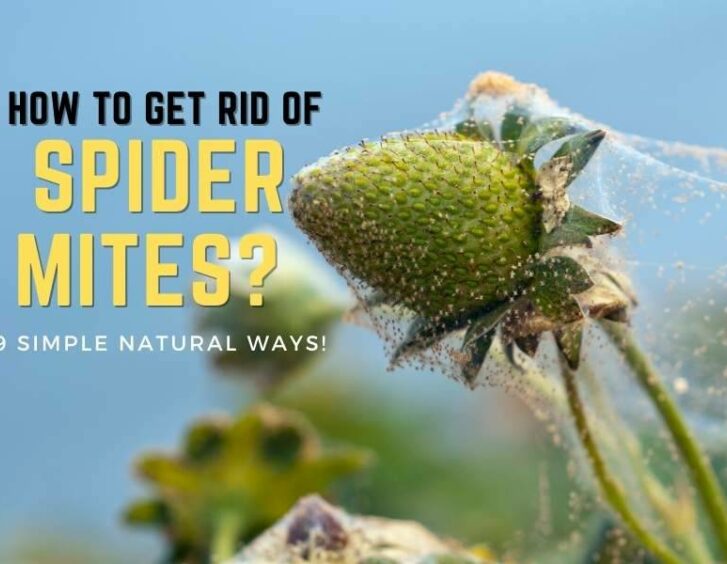Find out how you can naturally fight spider mites! These bugs feed on plants, affecting their overall health. They feed on plant cells, such as leaves' sap and cell contents, weakening the plants altogether. They also produce webbing that suffocates plants and blocks light from getting in. Follow our tips for fighting off these pesky insects.
Spider mites also occur in greenhouses and are one of the most critical and common pests in greenhouses. They feed on plants, taking out nutrients from leaves, stems, flowers, and fruit. Spider mites can also carry diseases that they transmit to plants when feeding.
.
How To Identify Spider Mites On Plants?
To the naked eye, spider mites look like tiny, moving dots (~2mm). They usually live in colonies on the undersurface of the leaves.
The mites are yellow, red, brownish-red, or clear in color. You can see the spider mites if you magnify your view with a glass.
One of the most obvious signs that spider mites are attacking your plant is the presence of webbing around your plants.
You can also take a piece of white paper, hold it under some leaves, and tap the leaf to knock the spider mites off. If there are lots of tiny red or brown bugs walking around on your paper, then you probably have an infestation!
Adult mites have a single sac-like oval body consisting of eight legs. They consist of two red eyespots on their headends.
Females carry numerous bristles over their bodies and appendages.
It would help if you also looked at the undersides of leaves, as that's where they usually hang out. Damaged leaves may show small white spots.
Spider Mite Eggs
Eggs are laid in clusters on leaves and hatch in about three days. During favorable conditions, a female may produce several hundred eggs for up to 3 or 4 weeks.
The lifecycle from egg to larva is 5-7 days, the life cycle from larva to adult is 8-11 days, and the adult stage lasts about 20 days.
.
Spider Mites Damage On Plants
A common indication of spider mites infestation is the white stippling of leaves. These small sap-sucking insects damage plants by removing chlorophyll from the cells. This results in a pale appearance in affected areas of the leaf. Eventually, leaves begin to dry and die if the infestation is not controlled.
In most cases, spider mites cause spotted or stippled yellowing of leaves as they feed on the undersides of foliage. Leaves will curl up and become brittle as infestation increases. Heavily-infested plants may appear off-colored with yellow foliage.
As mites are tiny, it is often difficult to detect them until an infestation has occurred. However, you can see the damage they cause pretty clearly once you have spotted them. If spider mites are attacking your plants, you must act fast!
If you are wondering how to get rid of spider mites naturally, fortunately, there are many natural approaches for spider mite control. It is always better to prevent and control an infestation before it becomes unmanageable.
.
Spider Mite Treatment: How To Manage Spider Mites?
Since the spider mites are so tiny, many people don't realize their plants have a problem until it's too late; spider mites often go unchecked for months before being discovered.
You don't need to resort to harsh chemicals or pesticides when you can fight these pesky bugs naturally instead! In this article, I'll talk about the eight best methods for getting rid of spider mites on house plants, hydroponics, and your home garden.
1. Watch Closely
Inspect plants regularly for any early signs of spider mites. Look for webbing around leaves or dark spots on leaves where mites have fed, and use a magnifying glass to look for any mites or eggs during the inspection. Monitor closely: If you find spider mites, even in tiny numbers, you will want to start spraying immediately before their populations can grow.
.
2. Physical Prevention
Using physical means to prevent spider mites from attacking your plants is a great way to go, and in this case, we recommend cleanliness.
-regularly spray plants at room temperature, filter water in hydroponics, and wipe leaves free of dust and dirt in soil gardens. This will discourage egg-laying and makes it harder for spider mites to find your plants.
-disposing of infested leaves and plants as soon as possible before the population grows too large. Many growers like to remove any plant heavily infested with spider mites because it will attract more to that plant, making them spread across the garden even faster!
3. Prevention
Planting repellant plants can help prevent and control infestations. Plants like rosemary, cilantro, and thyme produce toxic oils to spider mites. Placing these herbs at the perimeter of your greenhouse will help repel mites from entering the area. Many gardeners also successfully plant marigolds throughout their greenhouses as they produce a strong scent that will help repel spider mites.
4. Sanitation
Maintain clean and tidy garden beds and regularly remove debris like old leaves and dead plant material, as it can provide a food source for mites. Raking up those fallen nuts from walnut trees is also very beneficial as the decaying husks will be a significant food source for mites and other garden pests.
5. Suppression
If you have a small infestation in winter or early spring, remove the top layer of soil from around the plants where the spider mites are present to remove the spider mites in soil and discard it so they will not be able to grow back. This is especially helpful when dealing with greenhouse crops.
6. Strengthen Your Plants Natural Resistance
If you are having an issue with spider mites naturally, it is typically due to your plants being too stressed or unhealthy. Ensure you meet the plant's needs by providing adequate water and nutrients. Also, prevent overcrowding conditions that can reduce airflow and make maintaining optimal humidity levels more difficult for the plant. Mites may also attack the weakest and most vulnerable plants in your greenhouse. Be sure not to leave any sick or dying plant material behind, and remove any infested with spider mites.

Looking for the best app to identify any plant using your iPhone or android?
7. Biological Control
Biological control is another way to help prevent spider mites in your greenhouse. Predatory mites that feed on pest mites are commercially available but will not harm the plants. Introduce predatory insects to the garden, such as lady beetles (ladybugs). Also, you can use predatory mites such as Stratiolaelaps scimitus, a species of soil-dwelling predatory mite with a strong appetite for common pests like spider mites, root aphids, thrips, etc.
Predatory Mites
The predatory mites usually have longer legs than spider mites. Five major species of predatory mites are found commercially in the U.S. They are:
- Amblyseius fallicus
- Galendromus occidentalis
- Mesoseiulus longipes
- Neoseiulus californicus
- Phytoseiulus persimilis
Apart from preventive and biological controls, you can use several chemical treatments. Spinosad, insecticidal soap, and neem oil all work as spider mite spray. All these can be found at your local garden center and will kill the spider mites naturally and only target the spider mites you want to eliminate with no harm to beneficial insects.
However, if using any pesticide in your greenhouse, it is crucial always to read the label and use it following the directions before applying.
8. Organic Sprays
Insecticidal soap and horticultural oil are two organic sprays that can be used to kill spider mites. They act by suffocating the mites, so they must be sprayed directly onto the spider mites and will not work on eggs. However, you may have to spray multiple times, depending on your infestation amount. Be cautious; if you use too much, you may burn the leaves of young plants.
Spinosad is a selective biological insecticide that contains a naturally occurring bacterium that kills spider mites (and other pests like caterpillars). It only affects the nervous system of spider mites and not all insects, so its use in a greenhouse full of beneficial insects is ideal. Be aware that it takes at least 1-2 days to kill the mites after spraying them with Spinosad.
.
9. Chemical Sprays
Horticultural oil (such as Volck) will help control spider mite populations. It can be purchased as a ready-to-use product or made up yourself by mixing one teaspoon of horticultural oil with 1 gallon of water and adding it to your sprayer. The oil suffocates the spider mites, so it must be sprayed directly on them to work, but it will not affect their eggs. Be cautious when using oil sprays on young plants, as they can burn the leaves of older plants.
Be Cautious!
While applying various chemicals can help reduce or even eliminate an infestation, the chemicals could also harm your plants and the surrounding environment. Also, by using chemical sprays, you are spreading harmful pesticides throughout your greenhouse, which can cause other issues concerning pollinators like bees and butterflies.
Will Natural Spider Mite Remedies also Repel Cats from Plants?
Looking for natural spider mite remedies that won't repel your cats from plants? Consider using neem oil or a soap and water solution. These methods are effective for keeping spider mites at bay without harming your feline friends. Learn how to keep cats away while protecting your plants.
If The Problem Persists
If you continue to notice spider mites present even after making the necessary changes to reduce their impact on your plants, it may be time to get professional help. If you are not comfortable with pesticides or cannot find one to use that will work on the spider mites, call in a professional who is experienced in dealing with spider mites and plant-safe sprays.
In conclusion, spider mites can infest any greenhouse or your home garden. Greenhouses that grow mostly plants from tropical regions are especially susceptible. The high humidity levels in a greenhouse can lead to spider mites developing very quickly, frustrating any attempts to control them naturally. This is why a preventative treatment should be applied before a spider mite infestation occurs.
I hope this article has helped you better understand how to prevent spider mites. Remember, it is always best to act before an infestation occurs so you can minimize its impact on your plants.
Want to know more about 11 proven and simple steps for hydroponic pest control?

How to master gardening? Download these essential home and gardening ebooks today!
















